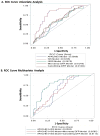Development of a genomic metric that can be rapidly used to predict clinical outcome in severely injured trauma patients
- PMID: 23388514
- PMCID: PMC3652285
- DOI: 10.1097/CCM.0b013e318277131c
Development of a genomic metric that can be rapidly used to predict clinical outcome in severely injured trauma patients
Abstract
Objective: Many patients have complicated recoveries following severe trauma due to the development of organ injury. Physiological and anatomical prognosticators have had limited success in predicting clinical trajectories. We report on the development and retrospective validation of a simple genomic composite score that can be rapidly used to predict clinical outcomes.
Design: Retrospective cohort study.
Setting: Multi-institutional level 1 trauma centers.
Patients: Data were collected from 167 severely traumatized (injury severity score >15) adult (18-55 yr) patients.
Methods: Microarray-derived genomic data obtained from 167 severely traumatized patients over 28 days were assessed for differences in messenger RNA abundance among individuals with different clinical trajectories. Once a set of genes was identified based on differences in expression over the entire study period, messenger RNA abundance from these subjects obtained in the first 24 hours was analyzed in a blinded fashion using a rapid multiplex platform, and genomic data reduced to a single metric.
Results: From the existing genomic dataset, we identified 63 genes whose leukocyte expression differed between an uncomplicated and complicated clinical outcome over 28 days. Using a multiplex approach that can quantitate messenger RNA abundance in less than 12 hours, we reassessed total messenger RNA abundance from the first 24 hours after trauma and reduced the genomic data to a single composite score using the difference from reference. This composite score showed good discriminatory capacity to distinguish patients with a complicated outcome (area under a receiver-operator curve, 0.811; p <0.001). This was significantly better than the predictive power of either Acute Physiology and Chronic Health Evaluation II or new injury severity score scoring systems.
Conclusions: A rapid genomic composite score obtained in the first 24 hours after trauma can retrospectively identify trauma patients who are likely to develop complicated clinical trajectories. A novel platform is described in which this genomic score can be obtained within 12 hours of blood collection, making it available for clinical decision making.
Conflict of interest statement
The authors have not disclosed any potential conflicts of interest
Figures




Comment in
-
It's all in the genes: moving toward precision medicine in critical illness.Crit Care Med. 2013 May;41(5):1363-4. doi: 10.1097/CCM.0b013e31827c02dd. Crit Care Med. 2013. PMID: 23591214 No abstract available.
References
-
- Probst C, Pape HC, Hildebrand F, et al. 30 years of polytrauma care: An analysis of the change in strategies and results of 4849 cases treated at a single institution. Injury. 2009;40(1):77–83. - PubMed
-
- Cothren CC, Moore EE, Hedegaard HB, et al. Epidemiology of urban trauma deaths: a comprehensive reassessment 10 years later. World J Surg. 2007;31(7):1507–1511. - PubMed
-
- Bamvita JM, Bergeron E, Lavoie A, et al. The impact of premorbid conditions on temporal pattern and location of adult blunt trauma hospital deaths. J Trauma. 2007;63(1):135–141. - PubMed
-
- Demetriades D, Murray J, Charalambides K, et al. Trauma fatalities: time and location of hospital deaths. J Am Coll Surg. 2004;198(1):20–26. - PubMed
-
- Bone RC, Balk RA, Fein AM, et al. A second large controlled clinical study of E5, a monoclonal antibody to endotoxin: results of a prospective, multicenter, randomized, controlled trial. The E5 Sepsis Study Group. Crit Care Med. 1995;23(6):994–1006. - PubMed
Publication types
MeSH terms
Substances
Grants and funding
- R24 GM102656/GM/NIGMS NIH HHS/United States
- R01 GM104481/GM/NIGMS NIH HHS/United States
- U54 GM-062119-10/GM/NIGMS NIH HHS/United States
- P30 AG028740/AG/NIA NIH HHS/United States
- K23 GM087709/GM/NIGMS NIH HHS/United States
- F32 GM093665/GM/NIGMS NIH HHS/United States
- U54 GM062119/GM/NIGMS NIH HHS/United States
- K23 GM-087709-03/GM/NIGMS NIH HHS/United States
- F32 GM-093665-01/GM/NIGMS NIH HHS/United States
- T32 GM008721/GM/NIGMS NIH HHS/United States
- R01 GM101401/GM/NIGMS NIH HHS/United States
- R01 GM081923/GM/NIGMS NIH HHS/United States
- R01 GM040586/GM/NIGMS NIH HHS/United States
- T32 GM-008721-13/GM/NIGMS NIH HHS/United States
LinkOut - more resources
Full Text Sources
Other Literature Sources
Medical

